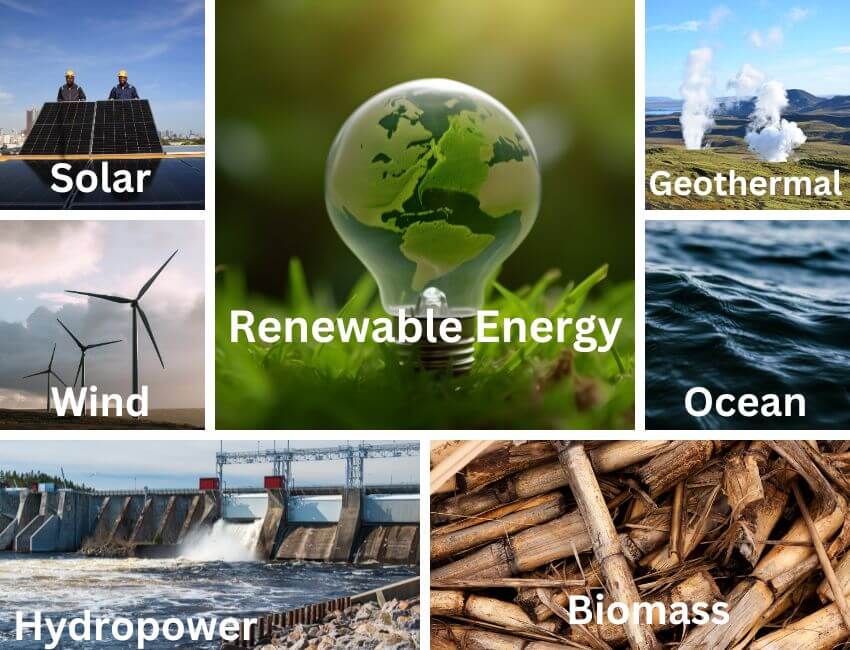Types of Renewable Energy
If You look around, you will find that energy is present everywhere. For example, cars run on the road because they get energy from gasoline. We get energy from food and carbohydrates, similarly, sunlight gives plants energy to grow; the blades of mills move due to wind energy, etc.
It’s important to note that energy cannot be created or destroyed; it simply transfers from one form to another.

There are two different sources from which we get energy: renewable energy sources and non-renewable sources. But in this article, we will learn about renewable energy.
What is renewable energy?
Types of renewable energy
- Solar Energy
- Wind Energy
- Hydropower
- Geothermal Energy
- Ocean Energy
- Biomass

Solar Energy
Solar power is the primary source of energy utilized by plants, animals, and humans. We use solar panels to trap sunlight energy and transform it into usable energy, such as heating water, buildings, pools, etc.
A photovoltaic cell, also known as a cell, directly converts sunlight into power.
Fun facts about solar energy
- The Noor Complex solar power farm is the world’s largest concentrated solar power (CSP) plant, located in the Sahara Desert in Morocco. (source)
- Alexandre-Edmond Becquerel, a 19-year-old French physicist, made the discovery of solar energy in 1839 while conducting an experiment on photography.
- Solar energy technologies and power plants do not produce air pollution or greenhouse gases when operating. (source)
- Solar energy is the most abundant energy resource on earth; 173,000 terawatts of solar energy strike the Earth continuously. That’s more than 10,000 times the world’s total energy use. (source)
- The International Space Station is entirely solar powered.
Wind Energy
Fun facts about wind energy
- Wind turbines are huge. The average length of a wind turbine is 210 feet, while turbine towers average height is up to 295 feet. (source)
- The United States has installed over 144,000 megawatts of wind capacity. (source)
- Federal data indicates wind-turbine service technician is the fastest-growing job in the USA. (source)
- Wind energy was first developed with windmills in 200 BC in Persia and China. (source)
- Prof. James Blyth built the first wind turbine for the purpose of generating electricity in Scotland in July 1887.(source)
Hydropower
Fun facts about Hydropower
- Hydropower is one of the oldest power sources on the planet.
- Three Gorges Dam, China, is the world’s largest hydroelectric facility. (source)
- Over 70 percent of Washington State’s electricity comes from hydropower. (source)
- At Cragside in Northumberland, England, William Armstrong created the first hydroelectric power system in history. (source)

Geothermal Energy
The term “geothermal” originates from the words “geo,” meaning ‘earth ‘ and “Therme,” meaning ‘heat.’ Geothermal energy is harnessed from the heat stored within the Earths core. This form of energy is employed for heating homes and buildings and for generating power.
Geothermal energy reaches the Earth’s surface in three ways:
- Volcanoes and fumaroles (openings in the earth where volcanic gases are released).
- Hot springs
- Geysers
Fun facts about Geothermal Energy
- Scientists have discovered that the temperature of the earth’s inner core is about 10,800 degrees Fahrenheit (°F), which is as hot as the surface of the sun.
- Most geothermal resources are near the boundaries of the earth’s tectonic plates.
- One of the most active geothermal areas in the world is called the Ring of Fire, which encircles the Pacific Ocean. (source)
Ocean Energy
Biomass
Biomass is an organic material that comes mainly from plants and animals. Biomass energy is a renewable type of energy that turns biomass into heat and electricity.
Fun facts about biomass energy
- Biomass is the largest form of renewable energy in Europe.
- A paper mill in Brazil illustrates the effect that biomass can have on climate protection. After replacing a gas boiler with a biomass boiler, it saves over 48,000 metric tons of CO2 every year. (source)
- Biomass provided about 5% of U.S. energy in 2022.
- Animal poop and human sewage can be used to produce biogas (renewable natural gas) through anaerobic digesters. (source)
Types of renewable energy: Helpful Resources
https://www.eia.gov/kids/energy-sources/geothermal/
www.eesi.org
https://www.energy.gov/articles/top-6-things-you-didnt-know-about-solar-energy
earth.org/facts-about-wind-energy
https://en.wikipedia.org/wiki/History_of_wind_power
